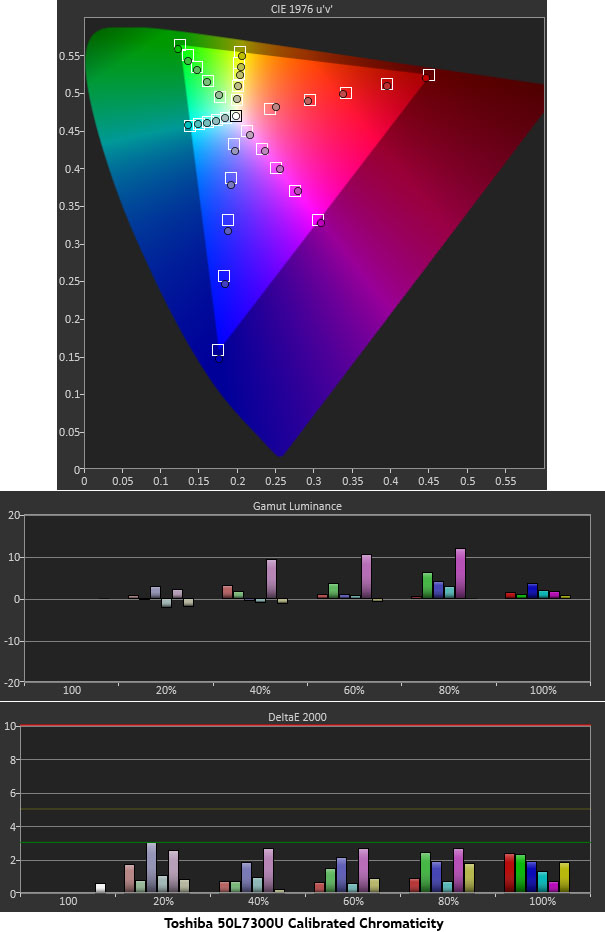Toshiba 50L7300U Review: A 50-Inch LED HDTV With Wi-Fi
You've seen us dramatically increase our display coverage over the last year, and now we're reviewing HDTVs too. Our first screen is Toshiba’s 50-inch L7300U Cloud TV with Wi-Fi. We run it through our lab and usability tests to see how it measures up.
Results: Color Gamut And Performance
Color gamut is measured using a saturation sweep that samples the six main colors (red, green, blue, cyan, magenta, and yellow) at five saturation levels (20, 40, 60, 80, and 100%), providing a more realistic view of color accuracy.
The 50L7300U’s picture modes produce different results in the color gamut test. The first chart was generated in the Standard mode at stock settings.
This is a perfect example of why we measure additional color saturation levels. Red, green, blue, and yellow at 100-percent saturation are pretty close to their targets, while cyan and magenta are fairly wide of the mark. The lower saturations are quite a bit off from their targets, too. The errors range from 11 to 19 Delta E.
The inaccuracy is compounded by super-high luminance values. Some colors are over 100-percent too bright, resulting in cartoon-like images that look unnaturally intense. A lot of the color detail is crushed as well, which removes all of the texture and depth from the picture.
This chart represents the Movie mode.
Even if you don’t calibrate, the 50L7300U’s color accuracy is far superior in the Movie mode. Our chart shows the gamut without any calibration, and the average error is 6.24 Delta E. The main problem is that the color luminance is still too high for every color (on the order of 15 to 50 percent too high). The CIE points aren’t too bad though.
Toshiba's CMS works very well for fixing these problems. Here is the result after grayscale and CMS calibrations.
Get Tom's Hardware's best news and in-depth reviews, straight to your inbox.
You can see that it's well worth putting the effort into calibration. The average error is now only 1.53 Delta E, resulting in an image that's far more natural and smooth-toned than before. The CMS doesn’t require too much tweaking to achieve this result, either. Adjusting the luminance values has the biggest impact on quality.
Let’s see how the 50L7300U stacks up to our other HDTVs and monitors.
As we saw in our grayscale and gamma measurements, the 50L7300U ranks with the best displays we’ve tested for color accuracy. A few years ago, an HDTV at this price point would likely have performed poorly and lacked any calibration controls. We’re glad to see technology that addresses performance rather than just adding more bells and whistles.
Current page: Results: Color Gamut And Performance
Prev Page Results: Grayscale Tracking And Gamma Response Next Page Results: Viewing Angles And Uniformity
Christian Eberle is a Contributing Editor for Tom's Hardware US. He's a veteran reviewer of A/V equipment, specializing in monitors. Christian began his obsession with tech when he built his first PC in 1991, a 286 running DOS 3.0 at a blazing 12MHz. In 2006, he undertook training from the Imaging Science Foundation in video calibration and testing and thus started a passion for precise imaging that persists to this day. He is also a professional musician with a degree from the New England Conservatory as a classical bassoonist which he used to good effect as a performer with the West Point Army Band from 1987 to 2013. He enjoys watching movies and listening to high-end audio in his custom-built home theater and can be seen riding trails near his home on a race-ready ICE VTX recumbent trike. Christian enjoys the endless summer in Florida where he lives with his wife and Chihuahua and plays with orchestras around the state.



